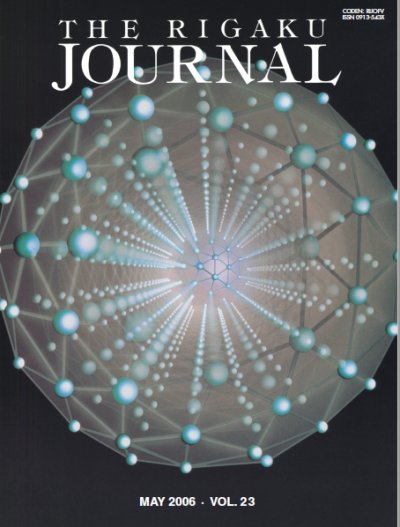Volume 23 - 2006

-
EditorialPages 01-02Annual Issue of The Rigaku Journal, And Congratulation to Dr. Victor Buhrke
Hideo Toraya and Ting C. Huang
The Rigaku Journal was first published in 1984 and is now twenty two years old. The Journal has published hundreds of technical articles and has been a major publication for the Rigaku Corporation to communicate with its customers and potential users. In view of the popularity of the Internet, we decide to redesign the Rigaku web site so that we can report new Rigaku developments and products as soon as they occur. Rigaku customers and potential users can access to these new information directly on the Rigaku web site. Instead of publishing bi-annually, The Rigaku Journal will now be published annually in May each year. It will continue to publish invited and contributed technical articles related to a wide range of X-ray diffraction and fluorescence applications.
-
Technical articlePages 03-12High Throughput de novo Structure Determination on a Home Source Using Quick Soaks, Actor and Parameter Space Screening
John P. Rose, Zhi-Jie Liu, Lirong Chen, Doowon Lee, Wolfram Tempel, M. Gary Newton and Bi-Cheng Wang
Protein structure determination has benefited significantly from the focus on high throughput methods required by the NIH Protein Structure Initiative (PSI). As part of our efforts related to PSI activities, we have established a state-of-the-art X-ray diffraction facility at the University of Georgia (UGA) with a design goal of providing X-ray characterization (cell constants and diffraction limit) for at least 100 protein crystals per day. In addition, a novel parameter space screening approach for optimizing the phasing and structure determination process has been developed at UGA, which dramatically speeds up the structure determination process. Together these components form an extremely efficient and versatile structure determination pipeline.
The system described above has been used for de novo structure determination associated with ongoing structural genomics activities, including the determination of three structures in four days from crystals briefly soaked in gold and mercury solutions.
-
Technical articlePages 13-24Advances in Data Analysis Of In Situ X-Ray Powder Diffraction Data: A Case Study of Rubidium Oxalate (Rb₂C₂O₄)
R. E. Dinnebier, B. Hinrichsen, P. Rajiv and M. Jansen
Methods have been developed to facilitate the data analysis of multiple two-dimensional powder diffraction images. These include, among others, automatic detection and calibration of Debye-Scherrer ellipses using pattern recognition techniques, and signal filtering employing established statistical procedures like fractile statistics. All algorithms are implemented in the freely available program package Powder3D which has been developed for the evaluation and graphical presentation of large powder diffraction data sets. As a case study to demonstrate the benefits of this software, the high temperature phases of rubidium oxalate Rb₂[C₂O₄], and its decomposition product rubidium carbonate Rb₂[CO₃], were investigated using fast, angle dispersive X-ray powder diffraction with an image plate detector.
-
Technical articlePages 25-39Considerations Regarding the Alignment Of Diffractometers for Residual Stress Analysis
Thomas R. Watkins, O. Burl Cavin, Camden R. Hubbard, Beth Matlock, and Roger D. England
Proper alignment of an X-ray diffractometer is critical to performing credible measurements, particularly for residual stress determinations. This article will emphasize practical aspects of diffractometer alignment and standards usage with regards to residual strain measurement. Essentially, what to do when one is confronted with a residual stress problem and an unfamiliar goniometer. Various alignment techniques, use of standards, and related issues will be discussed.
-
Technical articlePages 40-473D Micro X-Ray Fluorescence Analysis
Wolfgang Malzer
The paper introduces the principle and the basic properties of a rapidly emerging X-ray fluorescence (XRF) field in three-dimensional resolved micro XRF by means of a confocal setup. A fundamental parameter expression for the primary intensity was developed successfully in our institute. Its solutions for homogeneous materials permit an understanding of the confocal setup. The solutions also facilitate calibration with thick multi-element reference materials. The application of the 3D micro XRF for the investigation of the succession and composition of paint layers will also be given.
-
Technical articlePages 48-51SCXmini™ Benchtop Small Molecule Single Crystal X-ray Diffraction System
SCXmini represents a new paradigm in small molecule crystallography. Specifically engineered to provide colleges, universities, and industry with access to definitive molecular structure determination, this affordable and compact benchtop system was specifically designed to enable single crystal diffraction to become a routine laboratory method and teaching tool in the same way that NMR and FT-IR did more than a decade ago.
This newest member of the small molecule line of Rigaku integrated solutions was designed to offer affordable, reliable, easy-to-use, low cost-of-ownership access for routine solution of crystal structures. The combination of the new advanced Mercury2 CCD detector with a simplified goniometer, a sealed-tube X-ray source, and automated structure solution software makes the SCXmini the perfect routine instrument for use by non-crystallographer researchers as well as a highly accessible teaching tool for all levels of students.
-
New ProductPages 52-55SmartLab™ Automatic X-Ray Diffractometer
SmartLab is the world’s first high resolution diffractometer with horizontal sample mounting theta-theta geometry. Designed for the structural analysis of advanced materials and thin films, the system combines a uniquely flexible instrument geometry with a comprehensive knowledge-based software platform. SmartLab is exceptional in that it enables users with little or no expertise in diffraction methods to make advanced structural measurements quickly and easily.
Applications for the SmartLab exist across a wide range of disciplines, from basic research to process development, and materials production. Example areas of interest include: organic films, epitaxial films for semiconductor and optical devices, metal and alloy nano-particles, and magnetic films for next generation recording media.
-
New ProductPages A1-A10Appendix A. Description of Goniometers and Aspects of Data Collection
Thomas R. Watkins, O. Burl Cavin, Camden R. Hubbard, Beth Matlock, and Roger D. England
